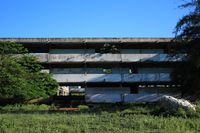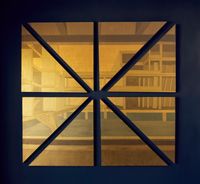SERIE SOLES CAÍDOS:
N.2 CUBA
FALLEN SUNS SERIES: N.2 CUBA
Painting
2021
Acrylic on canvas
1.10 x 1.10m
NO.2 Cuba, presents a model of schools in the countryside, in a state of ruin. The interior of the country is full of dozens of these buildings that have been left to the mercy of time, nature and saboteurs after the student centers in the countryside were eliminated from the educational system and this great project was closed.
Architectural language generally responds to the needs of the prevailing temporal power, understood in this case as political systems. These sets vary their role and importance over time depending on the evolution of each nation. In general, past and present systems have created different forms of architecture according to an ideological validation, the socialist system that polarized the world was not exempt from this pattern. it is a human need, to express ways of thinking in concrete facts and to leave traces, although sometimes these traces are lost, according to the interests imposed by the new times.
We know the need for change and the immediacy with which contemporary societies move, that constant consumption of new paradigms drives to replace the old spaces that fill other areas of historical memory. The transformation of society goes hand in hand with the transformation of a country's image, and old projects are marginalized and even forgotten for representing failed projects in some cases. Fallen Suns positions the viewer in front of a kind of "window" with the negative form of a lattice, where ruined urban landscapes of different societies are discovered.
No.2 Cuba is a work that adopts the polyform format imitating a negative view of the classic latticework of prefabricated architecture that began to develop in Cuba with the revolution. This work presents an analysis of the current state of Germany and its link to its old system, taking as a starting point the architectural traces left by the rage of a polarized world. The viewer would become a kind of judge who observes an image filtered by his own context of these facts-buildings isolated from the present, which positions him before a reflection on the traces of socialism as a system.

